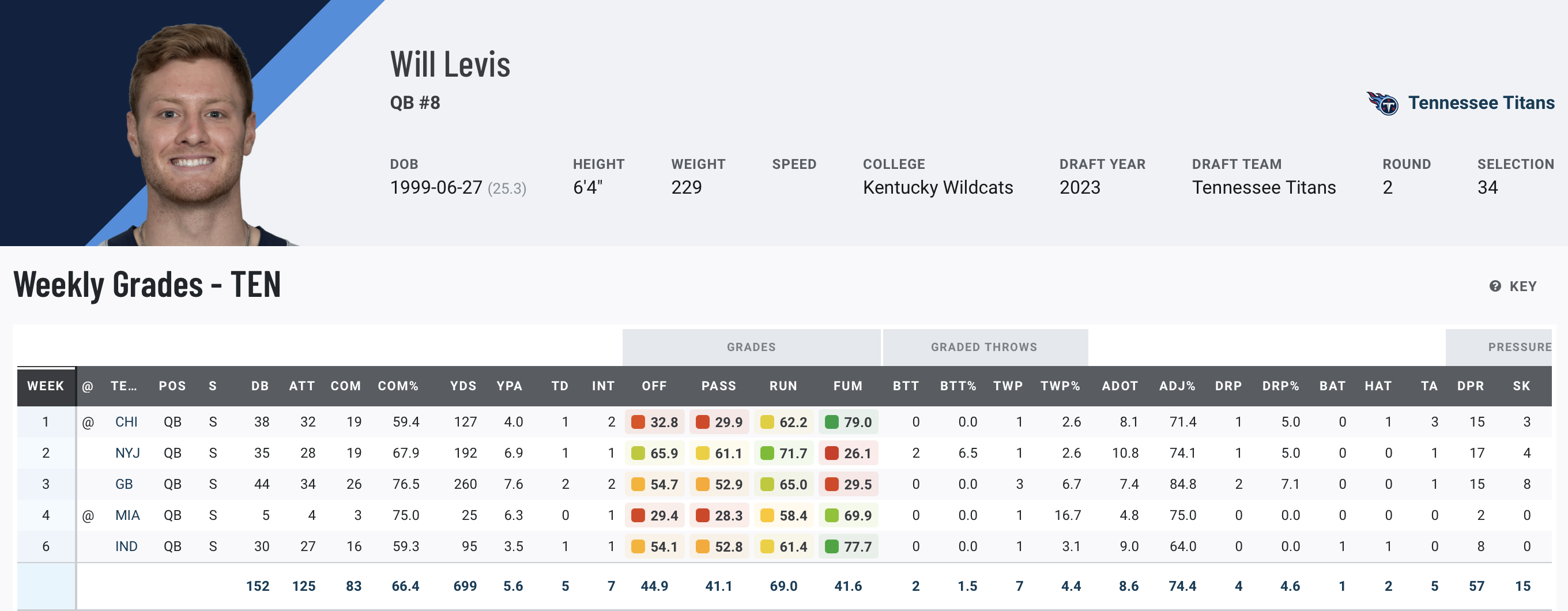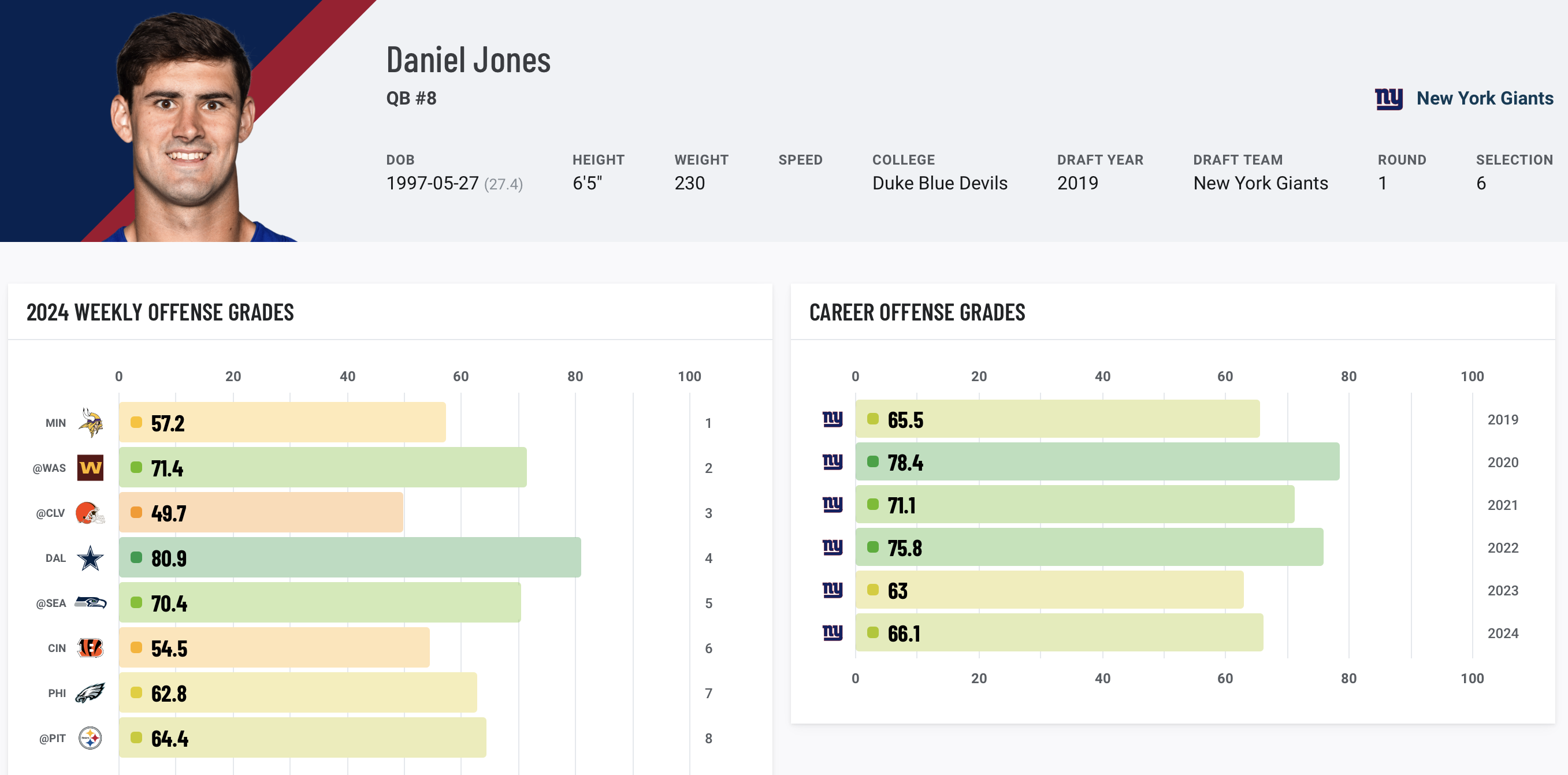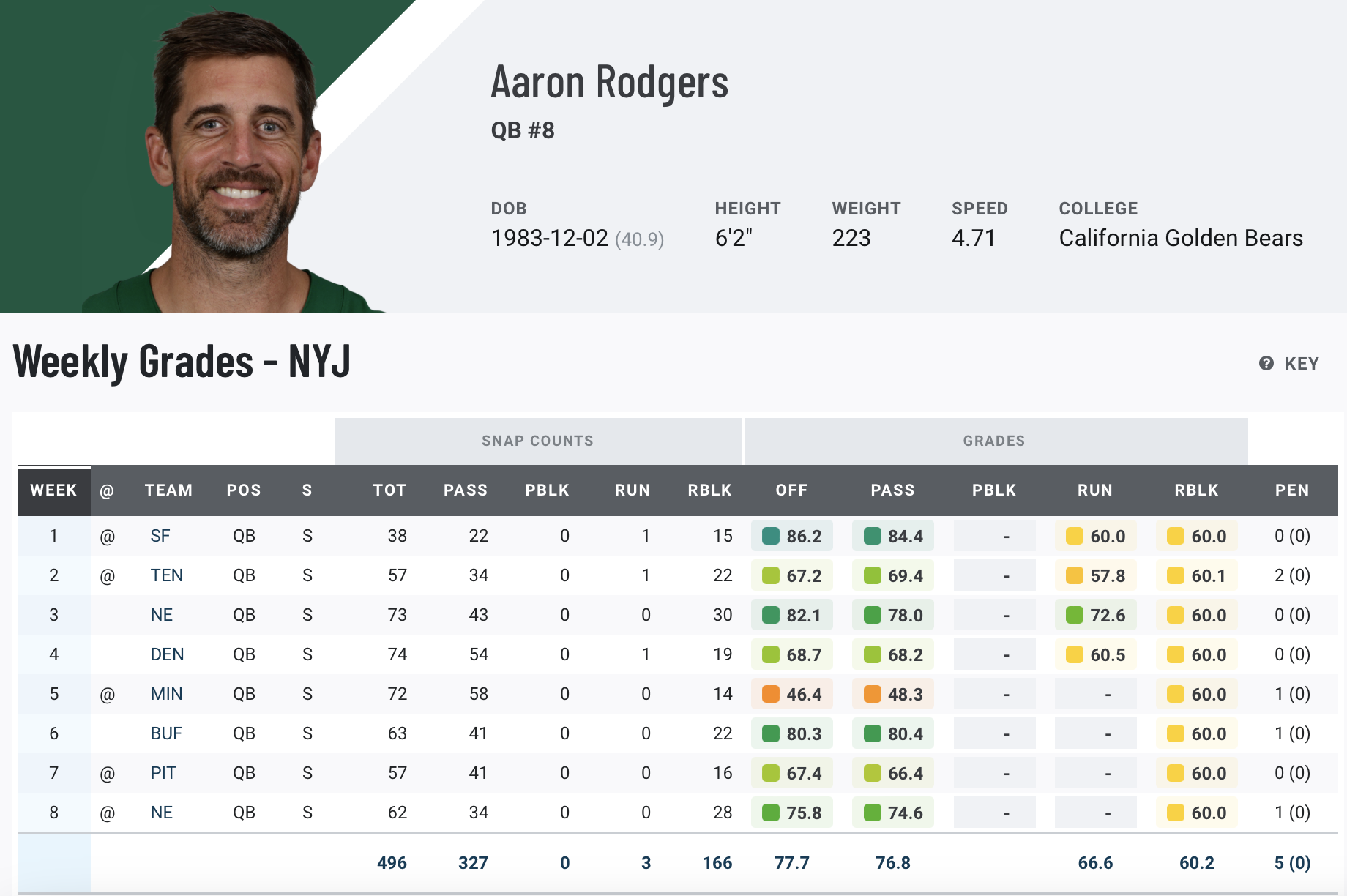• A fresh start in Cleveland: With Jameis Winston at the helm in Week 8, the Browns’ 0.260 EPA per passing play was easily a season high.
• The Vikings should turn to J.J. McCarthy: Sam Darnold has been up and down, and the Vikings have touted the Michigan product as their quarterback of the future.
• Unlock your edge with a PFF+ subscription: Get full access to all our in-season fantasy tools, including weekly rankings, WR/CB matchup charts, weekly projections, the Start-Sit Optimizer and more. Sign up now!
Estimated Reading Time: 11 minutes
With Week 8 in the rearview mirror, the 2024 NFL season has already offered a relatively adequate sample of games to evaluate players on every team. Sure, a player can get red hot at the end of the year (see: Jordan Love in 2023), but organizations have likely started to take stock of performance and will be making plans for positions heading into the offseason.
Through eight games, there appears to be a clear tier of NFL teams with little choice but to draft a signal-caller in 2025. Meanwhile, there’s still time for others to sort out their options.
Here’s an early roadmap of the best plans for squads with quarterback uncertainty to realize.
Cleveland Browns: Draft early
The Browns’ win over the Ravens perfectly encapsulated exactly why the Deshaun Watson experiment must come to an end. In his first start after Watson tore his Achilles, veteran backup Jameis Winston posted a 74.9 PFF passing grade with two big-time throws — and three turnover-worthy plays, in signature fashion.
It’s not as if Watson hadn't posted a passing grade that high this year, but Winston made the requisite plays to lead the team to victory — including a go-ahead touchdown pass to Cedric Tillman with 59 seconds left. The Browns’ 0.260 EPA per passing play in Week 8 was easily a season-high, and that’s not a coincidence.
As of now, the Browns would pick No. 8 overall in the 2025 NFL Draft. In a year where questions abound about the upcoming quarterback class, that seems like striking distance to land a top-three or top-four player at the position, enabling the organization to start new.
Carolina Panthers: Draft early
An organization never wants to admit that it made a mistake with a No. 1 overall pick, especially after only two years. But that’s the uncomfortable reality the Panthers may need to confront with Bryce Young.
The No. 1 overall pick ranks 36th in PFF passing grade this season among 37 qualified quarterbacks, being relegated to Andy Dalton’s backup. In 21 career starts, Young has secured an overall grade above 70.0 just twice. The fact that Young took major steps backward despite the Panthers' additions of a new play-caller, better weapons and an improved offensive line is deeply troublesome.
Having gone 1-7 so far this year, the Panthers are in the driver’s seat for the No. 1 overall pick: Carolina is projected for only four wins, according to PFF ELO. The team could justify selecting the best player available at that slot without much hesitation, but opting for a quarterback is also wise. Colorado’s Shedeur Sanders or Miami’s Cam Ward would figure into that conversation.
Tennessee Titans: Draft early
The Titans’ train has completely derailed. Tennessee is 1-6 with a -76 point differential and a 4% chance of making the postseason. Brian Callahan’s first season as head coach doesn’t seem salvageable, and he must revitalize his quarterback room before it’s too late.
Will Levis’ second season calling the shots hasn’t featured many encouraging developments. The 25-year-old ranks 37th among 37 qualified quarterbacks with a 41.1 PFF passing grade — a full 20 points below his 2023 mark. Levis’ turnover-worthy play rate has remained above 4.0%, but his big-time throw rate has dipped from 5.9% to 1.5%. Plus, the Kentucky product has played in only five games because of lingering shoulder injuries.
Callahan has been visibly unsettled by Levis’ numerous miscues in 2024, which doesn’t bode well. The Titans have given Levis adequate chances to prove his ability to be an NFL quarterback, and the results aren't up to par.
Assuming the Titans pick in the top three of the 2025 NFL Draft, Shedeur Sanders, Cam Ward or a wild card like LSU’s Garrett Nussmeier would go a long way toward upgrading the position on an offense with existing pieces, plus a defense holding its own.

Las Vegas Raiders: Draft early
The Raiders’ quarterback room was a morass going into 2024, and the group has been as bad as expected. Neither Aidan O'Connell nor Gardner Minshew ranks above 42nd in PFF passing grade among quarterbacks this year. In other words, there’s no long-term answer at quarterback on this roster.
Las Vegas could opt to sign a cheaper free agent — like Sam Darnold or Justin Fields — but it feels like it’s time to rip the bandage off and draft a marquee, dynamic young gunslinger. Vegas has been connected to each year’s top quarterbacks almost every season since the departure of Derek Carr but hasn’t actually pulled the trigger. With Tom Brady now in the fold from a team direction perspective, that feels likely to change.
Indianapolis Colts: Sign a veteran for competition
The Colts are 4-4 with their playoff aspirations still very much alive. Head coach Shane Steichen doesn’t have to totally worry about 2025 just yet, but questions are becoming harder to suppress about Anthony Richardson.
The former No. 4 overall pick was viewed as a high-ceiling, low-floor prospect who simply needed game reps, given his limited experience of starting in college. So far in the pros, the results have skewed more toward the bottom of that scale.
Richardson’s 48.7 PFF overall grade slots in at 51st among all quarterbacks to play this year, including 35th out of 37 with 100-plus dropbacks. His 5.0% turnover-worthy play rate is the third highest among qualifiers, with the second-year quarterback seemingly making inexplicable decisions on a weekly basis. On top of it all, injuries have limited Richardson to just 468 total snaps in two seasons.
It would feel a little rash for Steichen and general manager Chris Ballard to wave the white flag on Richardson so early, but the pressure is mounting. If Richardson doesn’t demonstrate some type of growth in the second half of 2024, assuming he regains the starting role after Joe Flacco was named the Week 9 starter, then he should certainly be on a tight leash in 2025. Flacco has actually performed better (70.0 passing grade) than Richardson this season while running the same offense.
Altogether, the fact the Colts have been a competitive team with Flacco and Minshew under center the past two years — and largely not under Richardson — isn’t a great omen for his play thus far.
New York Giants: Draft relatively early, trade Daniel Jones
Daniel Jones entered the 2024 season under intense pressure to perform, and the spotlight hasn’t dimmed. In his return from a torn ACL, Jones has largely played at the same level as in his lackluster 2023 campaign.
His 66.1 PFF overall grade is only three points higher than last year, even though his PFF passing grade has risen from 54.4 to 62.9. The good news is that Jones’ turnover-worthy play rate has declined from 4.1% to 2.6%, but his big-time throw rate has gone down to a minimal 2.0% — which is tied for the fifth lowest among qualified quarterbacks.
With two more years of his lucrative contract left after 2024, it doesn’t make much sense for the Giants to try to ride things out with No. 8 under center. Moving him this offseason is the best idea for both New York and Jones, especially given that head coach Brian Daboll and general manager Joe Schoen will presumably be back in 2025.
Consequently, the right decision would be to allow Daboll to hand-pick a quarterback. The organization displayed tremendous interest in some premier rookie quarterbacks in 2024, including Jayden Daniels and Drake Maye, but was unable to move up the draft board to nab them. A year later, it feels like Big Blue needs to select a signal-caller with either its first or second pick. The latter might make more sense if the Giants don’t pick inside the top five.

Pittsburgh Steelers: Draft relatively early, keep Russell Wilson/Justin Fields
Expectations were low for the Steelers’ quarterback room, given that both Wilson and Fields were cheap players with upside but also significant limitations. The cumulative results have reflected just that, with neither posting a PFF passing grade above 70.8 thus far. That outcome is probably slightly better than expected — and better than what Pittsburgh has endured at the position since Ben Roethlisberger’s retirement — but probably not good enough to warrant a full-time gig.
It would be logical for Pittsburgh to keep either Wilson or Fields as a baseline starter, but probably not both. Given that the upcoming free-agent class doesn’t boast many headliners, the Steelers likely wouldn’t benefit much from signing an outsider. Still, this room needs an upgrade, which is where the draft comes into play.
Sitting at 6-2, Pittsburgh will likely pick outside of the top half of the first round for the fourth straight year. That would handicap options in terms of high-profile quarterbacks, barring a trade-up. Nevertheless, going quarterback in either the first or second round seems like the smart move, considering the 2025 class is littered with fringe Day 1 prospects and intriguing Day 2 options.
Minnesota Vikings: Turn to J.J. McCarthy
The Vikings are 5-2 and likely to make the playoffs (65% chance, per PFF ELO). The team’s offense has been impressive, and Sam Darnold deserves some credit. His 72.7 PFF passing grade is a career high, and his 12 big-time throws are tied for the sixth most in football.
At the same time, Darnold hasn’t been incredible, per se. He still sits 16th among qualified quarterbacks in PFF overall grade, not to mention 14th in adjusted EPA per play. Those numbers reflect more of a league-average quarterback, and given how much the Vikings invested in McCarthy, that’s probably not worth retaining.
In light of the aforementioned weaker free-agent quarterback class, Darnold will likely fetch a deal worth at least $15 million per year, likely to be a team’s either QB1 or competition for a younger starter. In turn, Minnesota should simply turn to the cheaper McCarthy, if for nothing but to see what he’s capable of. After all, the Vikings took him 12th overall and have touted him as their quarterback of the future. That’s what the 2025 season is about determining.
New York Jets: Stick with Aaron Rodgers but draft early
The Jets are officially in free fall, sitting 2-6 with just a 9% chance of making the playoffs entering Week 9. Dysfunction is plaguing the team from the top down, but Rodgers remains a strength.
Rodgers’ 76.8 PFF passing grade ranks 12th, and his 1.5% turnover-worthy play rate is the third lowest among quarterbacks with 100 or more dropbacks. His mobility may be compromised at this stage, but it would be tough to envision more from a 40-year-old quarterback.
Given Rodgers' age, though, it would be prudent for the Jets to pursue long-term answers at the position. Doing so in the first round doesn't seem impossible, especially since the Packers did so in 2020 by selecting Jordan Love with Rodgers potentially nearing the end of his tenure.
It’s easy to view Rodgers as a scapegoat for the Jets’ broader problems — and he’s not beyond reproach, given the power he wields in the organization. But Rodgers still has one year left on his contract, so rolling with No. 8 for 2025 is a feasible option.

New Orleans Saints: Embrace existing competition
The Saints’ hopes of being an NFC contender are verifiably dashed after losing their sixth straight game. The team has a whopping $81 million in dead cap going into next season, making money difficult to navigate (as New Orleans has gotten accustomed to). As a result, the Saints don’t have a ton of realistic splashes to make — but given their existing quarterback situation, that might be fine as is.
Before his oblique injury, Derek Carr was performing at a very high level. Carr’s 87.8 PFF passing grade is a career high and still ranks second in the league. His 5.1% big-time throw rate also slots in the top 10.
Without Carr, the Saints’ backups haven’t fared effectively. Rookie Spencer Rattler has notched only a 54.7 PFF passing grade, including being highly subpar under pressure. Rattler’s 26.2 PFF passing grade under pressure is the second lowest among all quarterbacks to play this year.
New Orleans currently holds the No. 6 overall pick in the 2025 NFL Draft, which could make a signal-caller enticing. But given the team’s needs along the offensive line, aging defensive core and lengthy injury history, other positions would likely be a priority. The best situation for Dennis Allen (or whoever will be the team’s coach entering the offseason) is to enable Carr and Rattler to extract the most out of one another, especially since Carr won’t be a free agent until 2027.




 © 2024 PFF - all rights reserved.
© 2024 PFF - all rights reserved.